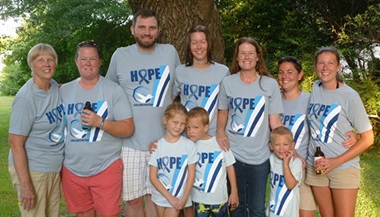Peutz-Jeghers Syndrome
Peutz-Jeghers syndrome (PJS) is a rare, inherited condition. It's passed to a child from a parent. PJS is an autosomal dominant genetic disorder. This means you only need 1 copy of the altered (mutated) gene to have PJS.
About 3 out of every 4 people diagnosed with PJS have a family history of the disorder. One out of 4 people have no family history. In this case, the gene mutation may have happened on its own. This is called a spontaneous mutation.
Genetic counseling with genetic testing can be done to diagnose PJS.
What is Peutz-Jeghers syndrome?
PJS symptoms often start early in childhood (before age 10). These can include:
-
Dark blue or brown moles around or in the mouth (including the lips) and around the eyes, nostrils, and anus. There may be dark moles on the hands and feet. These tend to show up during childhood and fade with age.
-
Growths in the lining of the gastrointestinal tract called hamartomatous polyps. These start in childhood. They cause pain, vomiting, bleeding, diarrhea, and blockages.
-
Polyps in other parts of the body, like the nose, lungs, and bladder
People with PJS are at higher risk of tumors that aren't cancer (benign) in the ovaries and testes. They're also at very high risk for certain types of cancer. These cancers start at younger than usual ages, such as the 40s.
How does Peutz-Jeghers syndrome lead to cancer?
In most cases, PJS is caused by changes (mutations) in the STK11 gene. The STK11 gene is a tumor suppressor gene. This means it controls cell growth and cell death.
More than 1 of the growth-control genes need to mutate before cancer can start. But the loss of STK11 is the first step in the process. What causes the other mutations is unknown.
Some people who have inherited a STK11 mutation never get cancer. This is because they never get the second mutation that stops control of cell growth and starts the process of tumor growth. This can make cancer appear to skip generations in a family. But the gene mutation is still present. All people with PJS have a 1 in 2 chance of passing the mutation on to each of their children. This is true whether or not they (the parent) develop cancer.
It's also important to remember that the STK11 gene is not located on the sex chromosomes. This means the mutation comes from either the mother's side or the father's side of the family.
What kinds of cancer are linked to Peutz-Jeghers syndrome?
Almost all people with PJS will be diagnosed with 1 or more of these types of cancer during their lifetime:
-
Stomach
-
Small intestine
-
Ovarian
-
Breast
-
Colon and rectum
-
Pancreas
-
Cervix
-
Lungs
Cancer screening when you have Peutz-Jeghers syndrome
Genetic testing can confirm if you have PJS. People with PJS can take steps to help reduce cancer risk. For instance, they can't use tobacco and must stay away from tobacco smoke. They can also start cancer screening at a young age. Screening tests are used to look for cancer before it causes symptoms.
It's very important that anyone with PJS talks with a healthcare provider about cancer screening . Here are some of the tests that might be used:
-
Upper endoscopy. Starting at age 8, a child with PJS should have this test regularly. It's used to look for polyps, tumors, and other problems in the esophagus.
-
Colonoscopy. A child with PJS should have this test done at age 8. If polyps are found, it should be repeated every 2 to 3 years. This checks for changes that could become cancer over time.
-
MRI. These scans can be done to watch for pancreatic cancer. This should be done starting at about age 30. If someone in the family has had pancreatic cancer, it should be started at 10 years younger than the age that family member was when they were diagnosed.
-
Mammogram. These tests should be started at age 20. They should be done every 2 to 3 years until age 40. After age 40, a mammogram should be done every year.
-
Yearly clinical breast exam. A healthcare provider should examine the breasts every year. Women might also want to talk with a provider about breast self-exams.
-
Yearly pelvic exam. These should be done with a Pap test and ultrasound for women with PJS, starting at age 25.
-
Yearly testicular exam. These should be done for men with PJS, starting in childhood.
The best screening plan varies for each person. Talk with your healthcare provider and genetic counselor to figure out the best plan for you.





